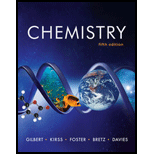
Concept explainers
Interpretation: Whether or not any one of the values in the given set of replicate measurement is an outlier is to be decided using Grubb’s test.
Concept introduction: The outlier value is the suspected value that has
The value of
To determine: If there is any outlier in the given set of replicated measurements.
Answer to Problem 1.76QP
Solution:
The measurement
Explanation of Solution
Given
The given data of the replicated measurements is,
The outlier in the given set of replicated measurement is identified for the value that is exceptionally higher or lower than the other values and it is known as suspected value.
In the given data, sample number
Therefore, the table for the calculation of the standard deviation is,
The mean of the measurement is given by the formula,
Substitute the values of all the measurements and the number of samples of peanuts in the above equation.
The standard deviation is calculated as,
Substitute the value of
The outlier value is the suspected value that has
The value of
Substitute the measurement of suspected value, mean of all measurements and the standard deviation in the above equation.
The critical value of
Therefore, the calculated value of
Conclusion:
The measurement
Want to see more full solutions like this?
Chapter 1 Solutions
Smartwork5 Printed Access Card for Use with Chemistry: The Science in Context 5th Edition (SmartWork Access Printed Access Card)
 ChemistryChemistryISBN:9781305957404Author:Steven S. Zumdahl, Susan A. Zumdahl, Donald J. DeCostePublisher:Cengage Learning
ChemistryChemistryISBN:9781305957404Author:Steven S. Zumdahl, Susan A. Zumdahl, Donald J. DeCostePublisher:Cengage Learning ChemistryChemistryISBN:9781259911156Author:Raymond Chang Dr., Jason Overby ProfessorPublisher:McGraw-Hill Education
ChemistryChemistryISBN:9781259911156Author:Raymond Chang Dr., Jason Overby ProfessorPublisher:McGraw-Hill Education Principles of Instrumental AnalysisChemistryISBN:9781305577213Author:Douglas A. Skoog, F. James Holler, Stanley R. CrouchPublisher:Cengage Learning
Principles of Instrumental AnalysisChemistryISBN:9781305577213Author:Douglas A. Skoog, F. James Holler, Stanley R. CrouchPublisher:Cengage Learning Organic ChemistryChemistryISBN:9780078021558Author:Janice Gorzynski Smith Dr.Publisher:McGraw-Hill Education
Organic ChemistryChemistryISBN:9780078021558Author:Janice Gorzynski Smith Dr.Publisher:McGraw-Hill Education Chemistry: Principles and ReactionsChemistryISBN:9781305079373Author:William L. Masterton, Cecile N. HurleyPublisher:Cengage Learning
Chemistry: Principles and ReactionsChemistryISBN:9781305079373Author:William L. Masterton, Cecile N. HurleyPublisher:Cengage Learning Elementary Principles of Chemical Processes, Bind...ChemistryISBN:9781118431221Author:Richard M. Felder, Ronald W. Rousseau, Lisa G. BullardPublisher:WILEY
Elementary Principles of Chemical Processes, Bind...ChemistryISBN:9781118431221Author:Richard M. Felder, Ronald W. Rousseau, Lisa G. BullardPublisher:WILEY





